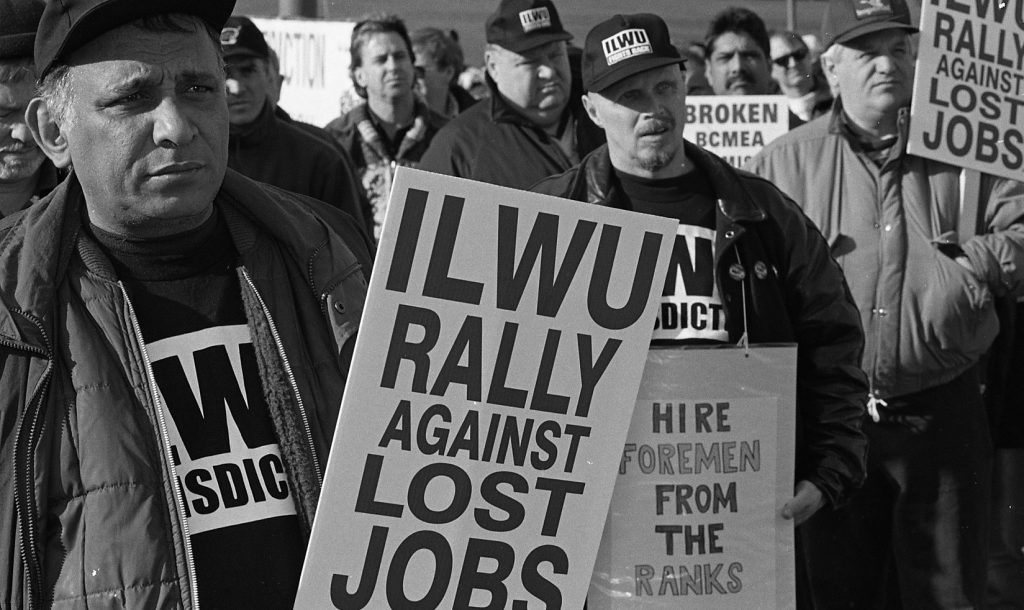
The International Longshore and Warehouse Union (ILWU) has long been a militant union in British Columbia, with a strong dedication to international solidarity and preserving their own labour history.
1946 was a significant year to the ILWU, much like the in IWA. It was the year that they were among multiple unions who came together at a San Francisco convention to consider “one big union” for all maritime and waterfront workers. The campaign was a success. At the same time, they kept an eye on international events, with the union’s international newspaper The Dispatcher reporting headlines like: “Starvation threatens six million Indians”, and a full-page article on the conditions for longshoremen in India.
With a global economy increasingly dependent on shipping, longshore workers have wielded their collective power by taking actions such as refusing to load ships to Nazi Germany or apartheid-era South Africa.
It was just before this period that we see South Asian labour appear on the Fraser River waterfront. Jack Singh was believed to be the first South Asian longshoreman in ILWU Local 502 (New Westminster). He was hired on in 1958; “Jack” didn’t recall a whole lot of trouble for being the first “East Indian” in the local. He talks about the increase of diversity he saw on the waterfront over his career.
He worked the “green chain” at Fraser Mills for several years before moving on to longshore work. He lied about his age to get a job at the mill, supposedly starting at age 14, and took the night shift because it paid 72 cents per hour — 5 cents more than day shift. He retired in 1995. [1]
According to past ILWU Canada President Tom Dufresne, there was a surge in hiring South Asian members around the years 1971-72, which tailed off as the longshore industry experienced a downturn around 1974.
“There have been South Asian workers in ILWU for many years, in Local 500 and 502 mainly. Longshore workers as you know were mainly day work, much the same as farmworkers. Hired today, finished today. Precarious employment. 1971-72 Canada embarked on a World Food Program supplying sacked malt to Bangladesh; the grain arrived in sacks in railcars or in bulk box cars and was sacked on the Coast. Throughout history, newly arrived immigrants would gravitate to day work to pay the bills. Hard work!”[2]
Partap Gill, a First Aid Attendant, is believed to be the first South Asian member of Local 500 (Vancouver). Yogesh Sood, a retired crane operator and member of Local 500, recalled experiencing racism in the 1970’s and seeking out Tom Dufresne and the ILWU to support him. [3]
As of 2021, the majority of the membership of Locals 500 & 502 are workers of South Asian descent and the Canadian Executive of ILWU has had two consecutive South Asian Canadian Secretary-Treasurers. Kuldip Grewal, uncle of ILWU Canada Secretary-Treasurer Bob Dhaliwal, was the first South Asian Canadian executive member of Local 502. Kuldip acted as Dispatcher and Treasurer, and was “instrumental in increasing the South Asian presence on the waterfront in Local 502”. He is the one who helped Bob to get his dispatch number, a crucial step to permanent waterfront work.[4]
- Jack Singh, interview by Dean Johnson, 2013, (Re)Claiming the New Westminster Waterfront fonds, New Westminster Archives, http://archives.newwestcity.ca/permalink/69097/. ↵
- Tom Dufresne, personal communication, 2021. ↵
- Yogesh Sood, personal communication, 2021. ↵
- Bob Dhaliwal, personal communication, 2021. ↵
